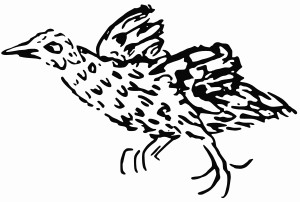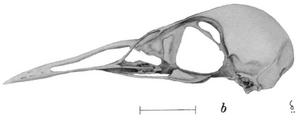Ascension crake facts for kids
Quick facts for kids Ascension crake |
|
|---|---|
 |
|
| Drawing by Peter Mundy, 1656 | |
| Conservation status | |
| Scientific classification | |
| Genus: |
Mundia
|
| Species: |
elpenor
|
The Ascension crake (Mundia elpenor) was a bird that could not fly. It lived only on Ascension Island in the South Atlantic Ocean. This bird is now extinct, meaning it no longer exists anywhere in the world. Like many other birds that lived on isolated islands and could not fly, it was a type of rail. Experts officially declared it extinct in 1994.
Contents
About the Ascension Crake
The Ascension crake was special because it was endemic to Ascension Island. This means it was found nowhere else on Earth. Scientists have discovered many old bones of this bird. These bones are called subfossils, and they were found near openings in the ground called fumaroles, which release steam and gases.
A 17th-Century Discovery
A traveler named Peter Mundy visited Ascension Island in 1656. He was a merchant who wrote about his travels. Mundy saw the Ascension crake and even drew a picture of it. He described the bird as being larger than a starling, with gray, white, and black feathers. Its eyes were red like rubies.
Mundy noted that the bird's wings were too small for it to fly. However, it was very fast on its feet. It could run quickly, using its small wings a little bit to help it move, similar to an ostrich. He also said it had a short beak and feet with separate toes.
What the Crake Ate and Why It Disappeared
The Ascension crake likely lived in the dry, desert-like parts of the island. Its main food source was probably the eggs of sooty terns.
Sadly, the Ascension crake became extinct because of new animals brought to the island by humans. It is thought that rats, which arrived in the 1700s, ate the bird's eggs and young. The crake might have survived a bit longer, but then feral cats were introduced in 1815. These cats would have hunted and killed the remaining birds, leading to their complete disappearance.
Its Place in the Bird Family
For a while, scientists thought the Ascension crake was closely related to another bird called the Atlantisia rogersi. However, newer studies in 2003 showed that these two birds are actually quite different. Because of these differences, scientists created a new group, or genus, for the Ascension crake. They named this new genus Mundia in honor of Peter Mundy, the first person to describe the bird.
See also
 In Spanish: Rascón de Ascensión para niños
In Spanish: Rascón de Ascensión para niños



